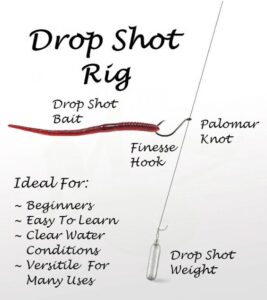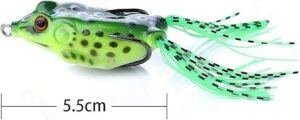How To Catch Big Summer Bass Using The Drop Shot Rig
Today, I’m going to be talking about a fishing technique that’s been a game-changer for anglers worldwide – the drop shot rig. Specifically, you’re going to find out about how this setup can help you reel in those elusive big summer bass that every angler dreams of catching.
This isn’t just about using any old rig; it’s also about understanding why the drop shot rig is particularly suited for the warm waters of summer when bass behavior changes. I’m here to help you with a practical guide that will equip you with the knowledge to not only catch bass but to target the larger, trophy-sized ones.

You might be wondering why the drop shot rig deserves so much attention. Well, its finesse and precision offer an unmatched advantage in presenting baits naturally amid the lazy summer swims of lethargic bass. This method could be your ticket to experiencing the rush of snagging a weighty bass from beneath the lily pads or off the deep-water ledges.
In my opinion, there’s no better time to sharpen your skills with this technique than the upcoming summer season. And don’t worry too much about mastering it right away. You can always adjust your approach down the road. So, let’s gear up and get ready to explore this incredible method step by step, beginning, of course, with the basics of your gear and setup in the next section.
The Basics of the Drop Shot Rig: Gear and Setup
I’m going to break down the nuts and bolts of putting together a drop shot rig. This isn’t just about tying a hook to a line; it’s about choosing the right components to catch those elusive summer bass. First off, you’ll need a light to medium-light spinning rod. Why? Because sensitivity is key. You want to feel even the subtlest take from a bass.
Pair that rod with a spinning reel that can handle 6 to 10-pound test fluorocarbon line or a 10-20lb braided main line with a fluorocarbon line leader. Fluorocarbon’s nearly invisible underwater, which is a big deal in the often-clear water you’ll find in summer. Trust me, bass are wary creatures, and stealth is your ally.
Hooks matter more than you might think. Look for a narrow gap, light wire hook around size 1 or 2. You’re going to want to rig it so the hook point faces up; this improves your hook set ratio considerably. Now, onto the main event: your baits. Soft plastic worms or minnows in natural hues will do wonders. If you want to match the hatch, get to know the forage in your fishing spot and mirror it.
As for your weight, choose something that resonates with you, but keep in mind that drop shot weights typically range from 1/8 to 1/2 ounce. The key is to use the lightest weight you can get away with while still maintaining contact with the bottom. That’s where you’ll find your bass, after all.
I really hope that you’re getting excited now. With this setup, you’re posed to present your bait right in the strike zone. You’ll be animating it in a way that is irresistible to big bass. Now let’s talk about how to pick out the best possible spots to drop that rig into.
Locating Prime Summer Bass Habitats
I’m going to let you in on a secret: finding the right spot is just as crucial as having the perfect rig. As summer heats up, so does the bass’ change in location and behavior. They’re not just hanging out anywhere; these fish are picky and will gravitate towards specific habitats that offer comfort and food.
You might be wondering where to start searching. Well, I’m here to help you with that. Start by scanning areas where bass seek refuge from the summer sun: think deep water pockets, shaded docks, underwater structures, and lively weed lines that provide both cover and access to prey.
Your success hinges on understanding that bass are influenced by water temperature and weather patterns. During the scorching midday heat, they often retreat to cooler depths or shaded areas. On the flip side, they may roam shallower waters during cooler parts of the day to feed. Pay attention to these patterns for a heads-up on where the big ones might be lurking.
As we transition into the next section, keep the insights about bass habitats in mind. They’ll be the foundation for successfully presenting your drop shot rig. If the bass are holding in transition zones between deep and shallow water, for instance, that’s where your drop shot needs to go.
Mastering the Technique: How to Work a Drop Shot Rig
So you’ve located the perfect spot where the big bass are likely hiding. Now, I’m going to get into the nitty-gritty of working that drop shot rig to entice those summer lunkers into biting. First up, you need to understand the actual mechanics. You’re going to be casting out, but instead of a standard retrieve, you’ll want to let the weight hit the bottom.
Once your rig is settled, the goal is to impart just enough action to the bait to mimic the movements of live prey. This isn’t just about jigging it wildly; it’s about subtle twitches and shakes that you’ll impart with your rod tip. You’re going to find out that sometimes, less is more. A gentle twitch can often be more effective than any elaborate dance you might be tempted to perform with your rod.
Think about the rhythm of your retrieval lightly. The occasional pause can be golden, as it gives a suspicious bass time to make a move. You want to make sure you maintain a slight tension in the line; this way, you’ll feel even the softest takes, which are common in the warm summer water when bass can be a bit lethargic.
Now, I also want to highlight the importance of maintaining contact with the bottom. For summer bass fishing, it’s crucial. Big bass often feed downwards during this season, so keeping your bait near the bottom increases your chances of a hit. Plus, this technique allows you to detect subtle changes in the bottom composition—a key indicator of potential bass hangouts.
So, with these expertise-driven techniques locked in, you’re well on your way to summer bass success. But don’t worry too much about getting it perfect on your first few tries. You can always adjust your approach down the road. And speaking of adjustments, let’s move onto some advanced tips and tricks to really get those rods bending.
Advanced Tips and Tricks for Big Bass Success
You’re going to find out about taking your drop shot rig from novice to expert with these advanced tips and tricks. While mastering the basics can get you quite far, sometimes you’ll want to pull out all the stops for those elusive big summer bass.
One key move is to adjust your rig according to the situation you’re facing. If you’re dealing with highly pressured waters, downsizing your bait can be a game changer, making your lure look more natural and less threatening to cautious fish.
Scent can play a massive role in convincing wary bass to bite. Don’t hesitate to infuse your soft plastics with attractant, or even better, opt for baits already impregnated with scent. This little edge can make a significant difference, especially when fish are not aggressively feeding.
Speaking of natural presentation, consider the color and action of your bait. Matching the hatch, meaning choosing a color that mimics local prey, can be critical in clear water conditions. Meanwhile, in murkier waters, brighter colors or baits that create vibration may yield better results.
I really hope that you consider experimenting with different drop lengths between the weight and the bait. Sometimes, a longer drop will present your bait above weedy areas, while other times, a shorter drop is ideal for suspending your bait right in front of the fish if they are hugging the bottom.
These strategies are designed to give you an edge, but always remain conscious about the health of the fishery. Next up, I’ll guide you through the best practices for handling and releasing bass to ensure their survival for future angling adventures.
Making the Catch: Ethical Angling and Effective Release
Now that you’re equipped with the tactics for snagging those big summer bass using the drop shot rig, I’m going to touch on a couple of crucial points: ethical angling and the art of effective release. When you respect the fish and the ecosystem, you’re ensuring that future anglers will continue to enjoy the thrill of the catch just as you have.
Ethical angling isn’t just about following the rules; it’s about adopting a mindset that values conservation over short-term gains. That means being aware of local regulations, fishing with barbless hooks, or using tactics that minimize harm to the fish.
When it comes to releasing a big bass, there’s a right way to do it. You’re going to learn the best practices for handling these magnificent creatures, which include avoiding excessive handling, supporting the bass horizontally when taking photos, and ensuring they’re fully revived before release.
Remember, your first attempt doesn’t need to be your last. If a bass swims off weakly, take it as a learning opportunity. I’m here to help you improve your release techniques so that each bass you catch has the best chance of survival.
Choosing something that resonates with you is crucial. If you’re passionate about bass fishing, extend that passion to become a steward of the waterways. Practice catch-and-release, encourage others to do the same, and be an active participant in the preservation of this wonderful sport.
I really hope that this guide not only improves your drop shot rig technique but also instills a sense of responsibility toward our aquatic environments. Fishing is a privilege that comes with the duty to protect. So, let’s all do our part. Thanks for reading, and here’s to many successful—and responsible—days on the water.



